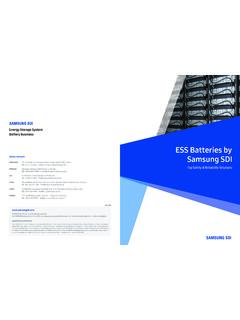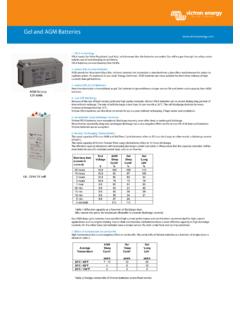Transcription of CompTIA Security+ Certification Exam Objectives
1 CompTIA security + Certification Exam ObjectivesEXAM NUMBER: SY0-601 Candidates are encouraged to use this document to help prepare for the CompTIA security + (SY0-601) Certification exam. The CompTIA security + Certification exam will verify the successful candidate has the knowledge and skills required to: Assess the security posture of an enterprise environment and recommend and implement appropriate security solutions Monitor and secure hybrid environments, including cloud, mobile, and IoT Operate with an awareness of applicable laws and policies, including principles of governance, risk, and compliance Identify, analyze, and respond to security events and incidentsThis is equivalent to two years of hands-on experience working in a security /systems administrator job content examples are meant to clarify the test Objectives and should not be construed as a comprehensive listing of all the content of this DEVELOPMENTCompTIA exams result from subject matter expert workshops and industry-wide survey results regarding the skills and knowledge required of an IT AUTHORIZED MATERIALS USE POLICY CompTIA certifications , LLC is not affiliated with and does not authorize.
2 Endorse or condone utilizing any content provided by unauthorized third-party training sites (aka brain dumps ). Individuals who utilize such materials in preparation for any CompTIA examination will have their certifications revoked and be suspended from future testing in accordance with the CompTIA Candidate Agreement. In an effort to more clearly communicate CompTIA s exam policies on use of unauthorized study materials, CompTIA directs all Certification candidates to the CompTIA Certification Exam Policies. Please review all CompTIA policies before beginning the study process for any CompTIA exam. Candidates will be required to abide by the CompTIA Candidate Agreement. If a candidate has a question as to whether study materials are considered unauthorized (aka brain dumps ), he/she should contact CompTIA at to NOTEThe lists of examples provided in bulleted format are not exhaustive lists. Other examples of technologies, processes, or tasks pertaining to each objective may also be included on the exam although not listed or covered in this Objectives document.
3 CompTIA is constantly reviewing the content of our exams and updating test questions to be sure our exams are current, and the security of the questions is protected. When necessary, we will publish updated exams based on testing exam Objectives . Please know that all related exam preparation materials will still be the ExamCompTIA security + Certification Exam Objectives Version (Exam Number: SY0-601)TEST DETAILSR equired exam SY0-601 Number of questions Maximum of 90 Types of questions Multiple choice and performance-basedLength of test 90 minutesRecommended experience At least 2 years of work experience in IT systems administration with a focus on security Hands-on technical information security experience Broad knowledge of security conceptsPassing score 750 (on a scale of 100 900)EXAM Objectives (DOMAINS)The table below lists the domains measured by this examination and the extent to which they are represented: DOMAIN PERCENTAGE OF Attacks, Threats, and Vulnerabilities 24% Architecture and Design 21% Implementation 25% Operations and Incident Response 16% Governance, Risk, and Compliance 14%Total 100% CompTIA security + Certification Exam Objectives Version (Exam Number.)
4 SY0-601) Phishing Smishing Vishing Spam Spam over Internet messaging (SPIM) Spear phishing Dumpster diving Shoulder surfing Pharming Tailgating Eliciting information Whaling Prepending Identity fraud Invoice scams Credential harvesting Reconnaissance Hoax Impersonation Watering hole attack Typo squatting Influence campaigns - Hybrid warfare - Social media Principles (reasons for effectiveness) - Authority - Intimidation - Consensus - Scarcity - Familiarity - Trust - Urgency Malware - Ransomware - Trojans - Worms - Potentially unwanted programs (PUPs) - Fileless virus - Command and control - Bots - Crypto malware - Logic bombs - Spyware - Keyloggers - Remote access Trojan (RAT) - Rootkit - Backdoor Password attacks - Spraying - Dictionary - Brute force - Offline - Online - Rainbow tables - Plaintext/unencrypted Physical attacks - Malicious universal serial bus (USB) cable - Malicious flash drive - Card cloning - Skimming Adversarial artificial intelligence (AI) - Tainted training data for machine learning (ML) - security of machine learning algorithms supply -chain attacks Cloud-based vs.
5 On-premises attacks Cryptographic attacks - Birthday - Collision - Threats, Attacks and VulnerabilitiesCompare and contrast different types of social engineering techniques. Given a scenario, analyze potential indicators to determine the type of security + Certification Exam Objectives Version (Exam Number: SY0-601) Privilege escalation Cross-site scripting Injections - Structured query language (SQL) - Dynamic link library (DLL) - Lightweight directory access protocol (LDAP) - Extensible markup language (XML) Pointer/object dereference Directory traversal Buffer overflows Race conditions - Time of check/time of use Error handling Improper input handling Replay attack - Session replays Integer overflow Request forgeries - Server-side - Client-side - Cross-site Application programming interface (API) attacks Resource exhaustion Memory leak Secure sockets layer (SSL) stripping Driver manipulation - Shimming - Refactoring Pass the hash Wireless - Evil twin - Rogue access point - Bluesnarfing - Bluejacking - Disassociation - Jamming - Radio frequency identifier (RFID) - Near field communication (NFC) - Initialization vector (IV) Man in the middle Man in the browser Layer 2 attacks - Address resolution protocol (ARP)
6 Poisoning - Media access control (MAC) flooding - MAC cloning Domain name system (DNS) - Domain hijacking - DNS poisoning - Universal resource locator (URL) redirection - Domain reputation Distributed denial of service (DDoS) - Network - Application - Operational technology (OT) Malicious code or script execution - PowerShell - Python - Bash - Macros - Virtual Basic for Applications (VBA) Given a scenario, analyze potential indicators associated with application attacks. Given a scenario, analyze potential indicators associated with network attacks. Attacks, Threats, and VulnerabilitiesCompTIA security + Certification Exam Objectives Version (Exam Number: SY0-601) Cloud-based vs. on-premises vulnerabilities Zero-day Weak configurations - Open permissions - Unsecured root accounts - Errors - Weak encryption - Unsecure protocols - Default settings - Open ports and services Third-party risks - Vendor management - System integration - Lack of vendor support - supply chain - Outsourced code development - Data storage Improper or weak patch management - Firmware - Operating system (OS) - Applications Legacy platforms Impacts - Data loss - Data breaches - Data exfiltration - Identity theft - Financial - Reputation - Availability loss Actors and threats - Advanced persistent threat (APT)
7 - Insider threats - State actors - Hacktivists - Script kiddies - Criminal syndicates - Hackers - White hat - Black hat - Gray hat - Shadow IT - Competitors Attributes of actors - Internal/external - Level of sophistication/capability - Resources/funding - Intent/motivation Vectors - Direct access - Wireless - Email - supply chain - Social media - Removable media - Cloud Threat intelligence sources - Open source intelligence (OSINT) - Closed/proprietary - Vulnerability databases - Public/private information sharing centers - Dark web - Indicators of compromise - Automated indicator sharing (AIS) - Structured threat information exchange (STIX)/Trusted automated exchange of indicator information (TAXII) - Predictive analysis - Threat maps - File/code repositories Research sources - Vendor websites - Vulnerability feeds - Conferences - Academic journals - Request for comments (RFC) - Local industry groups - Social media - Threat feeds -Adversary tactics, techniques, and procedures (TTP)Explain the security concerns associated with various types of different threat actors, vectors, and intelligence sources.
8 Attacks, Threats, and VulnerabilitiesCompTIA security + Certification Exam Objectives Version (Exam Number: SY0-601) Penetration testing - White box - Black box - Gray box - Rules of engagement - Lateral movement - Privilege escalation - Persistence - Cleanup - Bug bounty - Pivoting Passive and active reconnaissance - Drones/unmanned aerial vehicle (UAV) - War flying - War driving - Footprinting - OSINT Exercise types - Red team - Blue team - White team - Purple team Threat hunting - Intelligence fusion - Threat feeds - Advisories and bulletins - Maneuver Vulnerability scans - False positives - False negatives - Log reviews - Credentialed vs. non-credentialed - Intrusive vs. non-intrusive - Application - Web application - Network - Common Vulnerabilities and Exposures (CVE)/Common Vulnerability Scoring System (CVSS) - Configuration review Syslog/ security information and event management (SIEM) - Review reports - Packet capture - Data inputs - User behavior analysis - Sentiment analysis - security monitoring - Log aggregation - Log collectors security orchestration, automation, response (SOAR)Explain the techniques used in penetration testing.
9 Summarize the techniques used in security Attacks, Threats, and VulnerabilitiesCompTIA security + Certification Exam Objectives Version (Exam Number: SY0-601) Configuration management - Diagrams - Baseline configuration - Standard naming conventions - Internet protocol (IP) schema Data sovereignty Data protection - Data loss prevention (DLP) - Masking - Encryption - At rest - In transit/motion - In processing - Tokenization - Rights management Hardware security module (HSM) Geographical considerations Cloud access security broker (CASB) Response and recovery controls Secure Sockets Layer (SSL)/Transport Layer security (TLS) inspection Hashing API considerations Site resiliency - Hot site - Cold site - Warm site Deception and disruption - Honeypots - Honeyfiles - Honeynets - Fake telemetry - DNS sinkhole Cloud models - Infrastructure as a service (IaaS) - Platform as a service (PaaS) - Software as a service (SaaS) - Anything as a service (XaaS) - Public - Community - Private - Hybrid Cloud service providers Managed service provider (MSP)/ Managed security service provider (MSSP)
10 On-premises vs. off-premises Fog computing Edge computing Thin client Containers Micro-services/API Infrastructure as code - Software-defined networking (SDN) - Software-defined visibility (SDV) Serverless architecture Services integration Resource policies Transit gateway Virtualization - Virtual machine (VM) sprawl avoidance - VM escape Architecture and DesignExplain the importance of security concepts in an enterprise environment. Summarize virtualization and cloud computing concepts. security + Certification Exam Objectives Version (Exam Number: SY0-601)Summarize secure application development, deployment, and automation concepts. Summarize authentication and authorization design concepts. Environment - Development - Test - Staging - Production - Quality assurance (QA) Provisioning and deprovisioning Integrity measurement Secure coding techniques - Normalization - Stored procedures - Obfuscation/camouflage - Code reuse/dead code - Server-side vs.





